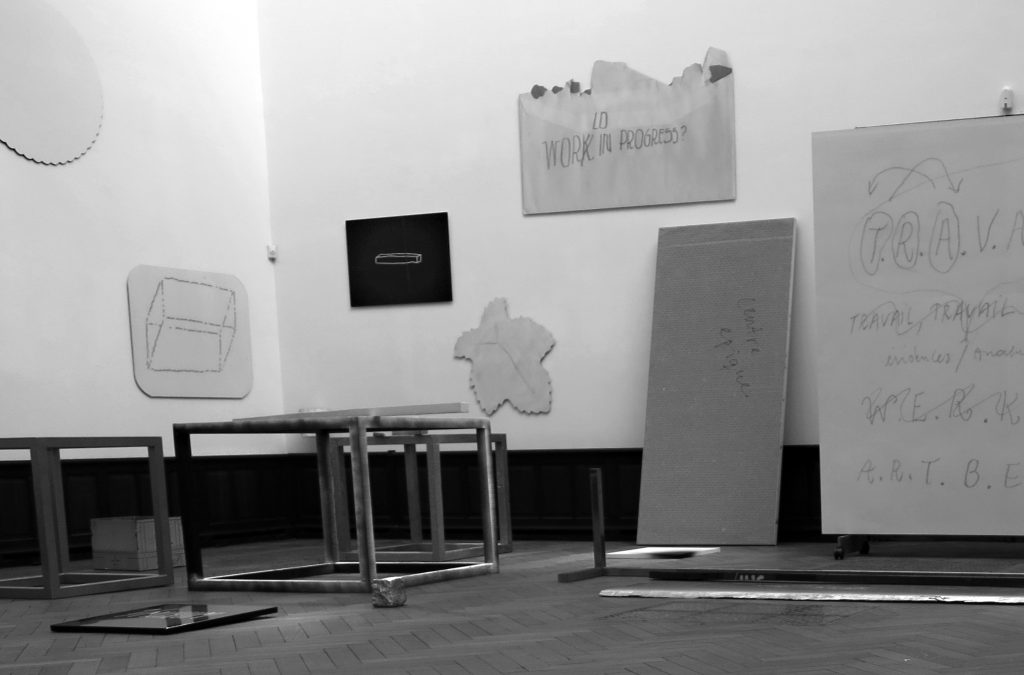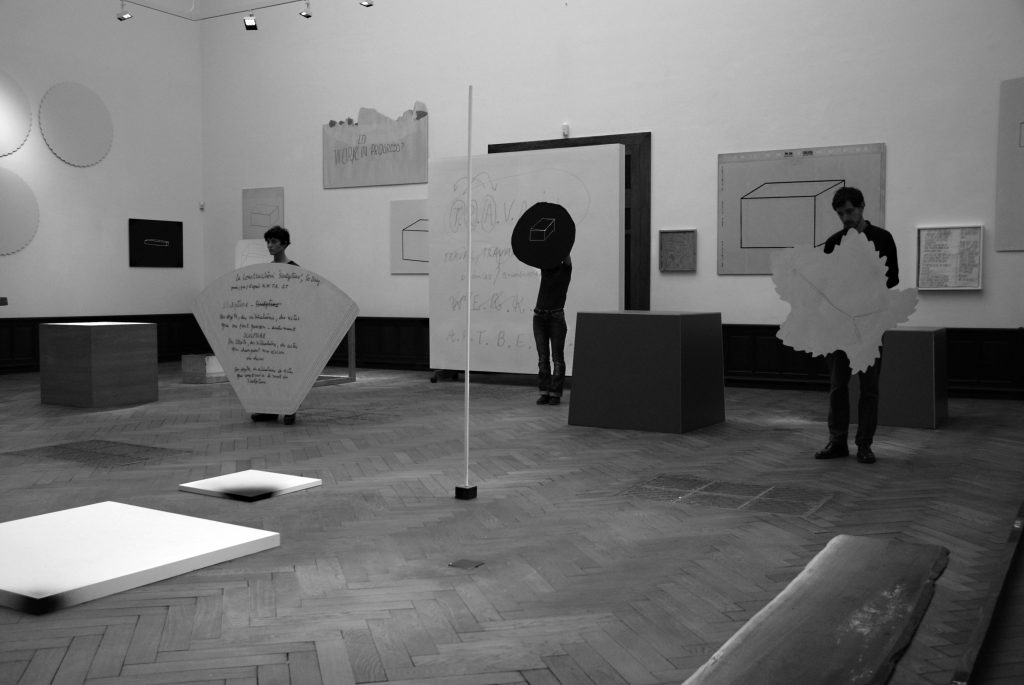The Pre-History
of Zero
1 / Museum
Kunsthaus Lempertz, Brussels
12.09.15 – 9.10.15
Zero: the number of things you have when you don’t have anything.
A definition found by Joëlle Tuerlinckx in the
Mathematics Section of the Boston Museum of
Science, in 1996.
Joëlle Tuerlinckx’ series of line drawings, Dessins Sous Zéro ( literally translated in English as ‘drawings below zero’ ), made in 2004, started from the artist experimenting with the compression tool on her computer. Unusually for her, Tuerlinckx had been busy sketching what she describes as a set of ‘baroque serpentine drawings’ ¹ for an exhibition in Karlsruhe, in the ‘baroque berceau’ region of Germany, when she pressed a button on the keyboard and the whole graphic confection collapsed, in a single moment, down to a single flat line. Reflecting upon this ‘moment zero’, as she pictures what now displayed before her, looking more like the very beginning of a sketch rather than the sum of her recent efforts, Tuerlinckx was surprised by the realisation that ‘what appeared to be merely the commencement of a drawing can have a long story before it starts.’ Subsequently she came to refer to this revelation as ‘the pre-history of language’.
The next surprise came a short time afterwards when she attempted to decompress the drawing again, only to find that it re-emerged as a completely different, rectilinear pattern. The previous baroque serpentine drawing had been transformed into a strict geometrical set of lines, through the action of the computer processor. There was no going back. For Tuerlinckx, however, this unexpected outcome was ‘a wonderful discovery… that baroque and minimalism touch each other’, an idea that became the basis for the ensuing series of works. Typically, the artist’s response to the corruption of her drawing by the computer system was to adapt her own methodology accordingly. As with the serial adaption of the title of her recent major exhibition series, ‘Wor( l )( d )( k ) in Progress?’, transiting from ‘work’ to ‘world’ to ‘word’ across three venues, her method is to be constantly ‘in progress’, and so to remain open to whatever may arise. Catherine Wood has described this approach as ‘a kind of continuous perceptual present where manifold possibilities of meaning proliferate’. ² By responding, step-by-step, in ‘real-time’, to the formal disciplines and constraints of language – or to the formal conventions of the art institution, in ‘real-space’ – Tuerlinckx nimbly tiptoes around the regulation of reductive equivalence.
With regard to the notion of ‘reductive equivalence’, Friedrich Nietzsche’s essay On Truth and Lies in an Extra-moral Sense puts forward the idea that all language is essentially ‘a lie’, because no two referents are, strictly speaking, identical.
‘Every word immediately becomes a concept, inasmuch as it is not intended to serve as a reminder of the unique and wholly individualized original experience to which it owes its birth, but must at the same time fit innumerable, more or less similar cases – which means, strictly speaking, never equal – in other words, a lot of unequal cases. Every concept originates through our equating what is unequal.’ ³
Thus we lie when we call two different leaves ‘leaves’; we ignore some different characteristics, and focus on those that are the same. We notice traits held in common only because it is useful to do so. Language is made possible only by what Nietzsche calls a ‘residue of metaphor’, the ‘dead bony remainder’ of a metaphor, that is, of a word that was initially unique and referred only to a single referent. The momentary, unique conjunction of two different elements is codified and petrified by ‘useful language’, and its ultimate perfection, ‘science’.
Tuerlinckx’ work can initially seem scientific, even mathematical, in its empirical process-based inquiry. Zero is a frequent point of reference. Diagrams of unknown objects, comparatively similar-looking geometrical forms and mysteriously specific measurements abound. At Kunsthaus Lempertz the gallery space is transformed into a kind of working laboratory, filled with experiments in progress. Rather than factual observation, however, her practice gravitates towards the creation of language, generating systems of signification and of categorisation that remain unexplained, just short of collapsing into meaninglessness. Rather than revealing underlying equivalences, the work seems to emerge out of these particular processes of abstraction.
The essential character of language is its power of abstraction; that is to say its distance from the reality of things. In Nitetzsche’s critique, negativity is the essence of language. The word ‘tree’ is not the same as the tree that stands in the park outside, but it is also not the same as any other tree. It is the negation of all particular real trees for the sake of an idea of a tree. It is precisely this distance from reality that provides language with the power to negate the actual, individual thing, for the sake of the idea of a thing. Thus literary theorist Maurice Blanchot writes, ‘speech has a function that is not only representative but also destructive. It causes to vanish, it renders the object absent, it annihilates it’. ⁴
The ‘present tense’ of Joëlle Tuerlinckx’ visual poetics actively seeks to elude such negativity, evading the annihilation of reductive equivalence by inventing its own parallel systems of difference and repetition. Impossibly, it seems to attempt to abstract our experience and, simultaneously, to immerse us in the physical materiality of perception: an encounter that is at once conceptual and phenomenological. A simple baton of wood has the word ‘Objet’ written upon it in pencil, placed next to a similar piece of wood labelled ‘A’, besides another baton labelled ‘a’ and a rough paint-stick marked ‘A’, that on closer inspection we discover is carefully crafted out of paper. In order to achieve such a state of elusive immediacy – of evanescence – the artist must constantly ‘duck and dive’, dancing on the border’s edge of language, between sense and non-sense, mimicking its structures whilst deftly side-stepping its destructive ‘equation of the unequal’. Thus Tuerlinckx continually devises her own individual taxonomies, her own idiolectic lexicon, her own embodied metrics, as – in Julia Kristeva’s term – a ‘subject-in-process’. ⁵
Kristeva’s notion of the subject-in-process is represented in the form of a semiotic chora. This is the place of perpetual renewal in language, a chaotic space that is closely related to the infantile ( pre-Oedipal ) condition, as an emotional field, tied to our instincts, which dwells in the fissures and prosody of language rather than in the denotative meanings of the symbolic order. A sort of ‘dancing body’ ( from the Greek khoreia, meaning ‘dance’ ),the semiotic chora is in perpetual motion, actively resisting the discipline and containment of the symbolic order. It energises the sign ( as well as the subject ) by placing expulsion ( of the abject maternal environment ) at the core of its structure. Just as dance allows the dancer to explore an infinite progression of bodily movements, the semiotic chora presents an infinite potential for creating signifying movements.
If the subject-in-process draws its chaotic energy from a pre-Oedipal sense of boundless omnipotence, then the reductive equivalence of the symbolic order, and the relational mediation of the object-world, actively works to reduce all of this limitless desire down to zero. The all-encompassing subjective reality, that hitherto contained everything, is compressed down to a single flat line, which marks the beginning of an orderly, Oedipal history. How are we to resist such a process of linguistic annihilation and re-connect with our own ‘pre-history’? As Antonin Artaud put it, how can we learn, again, ‘to dance wrong side out as in the frenzy of dance halls’? ⁶

1 / Museum ( X Objets Publiquement Mis En Scène )( X Objecten Publiek Getoond ) Galerie Nagel Draxler in Salle de ventes Lempertz, Brussel, 2015 ©JT. 《1/美术馆》(‘X个客体的公演’),兰伯茨拍卖行,布鲁塞尔,2015 © JT.
On encountering the transitional space created by Tuerlinckx at Kunsthaus Lempertz, which initially appears playful and haphazard, we soon find, to the contrary, that we are consumed within an all-enveloping subjective reality, located at the shifting borderline between inner and outer worlds; between the interiority of absolute omnipotence and the external reality of reductive equivalence. The elusive immediacy of this ‘moment zero’ evaporates, however, as soon as it is contained within the fixity of representation, henceforth only to exist as an absence within the decompressed history of its interpretation – the evanescence of the visual poetics of a subject-in-proc ( gr ) ess.
‘The thing was there, we grasped it in the living motion of comprehensive action – and once it has become an image it instantly becomes ungraspable, non-contemporary, impassive… the present thing in its absence, the thing graspable because ungraspable, appearing as something that has disappeared, the return of what does not come back.’ ⁷ ( Maurice Blanchot, The Two Versions of the Imaginary, 1955 )
1. Joëlle Tuerlinckx, in conversation with the author.
2. Catherine Wood, ‘Stories of 0’, Afterall, 10 ( 2004 ), 10 – 19.
3. Friedrich Nietzsche, ‘On Truth and Lies in an Extramoral Sense’ in: The Portable Nietzsche, ( London: Penguin, 1977 ), pp. 42 – 47.
4. Maurice Blanchot, The Work of Fire, ( Stanford, CA: Stanford University Press, 1995 ).
5. Julia Kristeva, Revolution in Poetic Language ( New York: Columbia University Press, 1984 ).
6. Antonin Artaud, To Be Done with the Judgement of God, 1947.
7. Maurice Blanchot, ‘The Two Versions of the Imaginary’, in: G. Quasha ( ed. ) The Station Hill Blanchot Reader ( New York: Station Hill, 1999 ), pp. 424 – 425.
零的史前史
《1/博物馆,丘耶勒·图林克斯》
布鲁塞尔,莱姆泊滋艺术中心
2015年9月12日至10月9日
译者:贺潇
‘零,当你一无所有时你所拥有的事物的数量。’
——丘耶勒·图林克斯在波士顿科学博物馆数学部找到的定义,1996年
丘耶勒·图林克斯2004年创作的线描绘画系列《零以下的素描》,始于艺术家用电脑上的压缩工具软件开始的实验。与她通常创作不同的是,当时图林克斯正忙于为一次在卡尔斯鲁厄的展览而描绘一系列她形容为‘巴洛克式的蜿蜒素描’1,那是在德国‘巴洛克摇篮’的地区,当时她按下了键盘上的一个键,结果整个图像一秒钟之内就崩溃了,成了一个单纯平面的线条。反思这个‘零度时刻’,她想象现在在她面前所呈现的,看上去更像是一幅草图,而不是她近来的全部努力。图林克斯被这样一种‘看起来只是一幅素描开始,但在它之前却有一段漫长的故事’的认知所震惊。结果,她把这个启示称作‘语言的史前史’。
不久之后就出现了接下来的震惊,当时她正尝试再次把素描解压缩,我们发现她的作品重现为一个完全不同的直线的图案。之前巴洛克式蜿蜒曲折的素描通过计算机处理器的作用,已经转化成一个线条组成的严格的几何图案,根本没有折回的可能。不过对于图林克斯来说,这种出乎意料的结果‘是一个奇妙的发现……巴洛克和极简主义彼此触及’,这个想法成了接下来一系列作品的基础。典型的是,艺术家对计算机系统对她的素描的破坏所做的反应,就是要相应地调整自己的方法。就像最近在大型展览系列中标题的连续调整一样,《进行中的( 作品 )/( 世界 )/( 言语 )》,在三个展场中标题从‘作品’转换为‘世界’,又转换为‘言语’,她的方法是一直处于‘进行中’,而且对任何可能提出的问题保持开放。凯瑟琳·伍德把这种手法称为‘某种认知的不断呈现,展现了意义扩充的可能性’。2通过一步一步地‘实时’回应语言的形式规训和约束——或者说是在‘真实空间’中艺术机构的形式上的惯例——图林克斯灵活而小心翼翼地试探还原的对等事物的规则。
就‘还原的对等事物’这个概念而言,弗雷德里希·尼采的《论真理和谎言:道德之外的意义》中指出了这一概念,即所有语言本质上都是‘谎言’,因为严格说来,没有两个指示对象是同一的。
‘每一个词句立刻就成为一个概念,并不是要充当独特性和完全个体化的原始经验的提示,这原本是它的义务,但必须同时适合于无数多少有些类似的情形——严格说来,这就意味着从没有平等——换句话说,是大量不平等的情形。每一个概念的产生都来自我们把不对等的事物视为对等’。3
因此,当我们把两片不同的叶子叫做叶子的时候,我们是在说谎,因为我们无视了其中一些不同的特色,只是着眼于相同的地方。我们只是注意了共同的特性,因为这么做是有用的。语言只有通过尼采所谓‘隐喻的残余’,隐喻的‘尸骨一般的提示’才成为可能,也就是说,一个词句最初就是独特的,仅仅指向单一的指示物。两个不同元素暂时的、独特的结合,被‘有用的语言’以及它完美的终极,即‘科学’,代码化并固定下来。
图林克斯的作品初看似乎是科学的,甚至是数学的,是基于经验过程的探索。零是一个惯用的参照点。未知对象的图解,看上去相对类似的几何形式以及神秘的特殊尺度。在莱姆泊滋美术馆,展览空间被转化成为一种实验室,充满了正在进行的实验。她的创作时间并非对事实的观察,而是指向了语言的创造,形成意义与分类的体系,仍然无法解释,只是免于陷入无意义。她的作品并非揭示潜在的等值,更似乎是从这些特定的抽象化过程中显现出来的。

《1/美术馆》(‘X个客体的公演’),兰伯茨拍卖行,布鲁塞尔,2015 © 克里斯朵夫·芬克. 1 / Museum ( X Objets Publiquement Mis En Scène )( X Objecten Publiek Getoond ) Galerie Nagel Draxler in Salle de ventes Lempertz, Brussel, 2015 ©Christoph Fink.
语言的基本特征就在于其抽象的力量,也就是说远离了现实事物。按照尼采的批判,否定性是语言的精髓所在。‘树’这个词和栽种在外面公园里的树不是一回事,而且和任何其他的树也不是一回事。它是对所有具体真实的树的否定,因为它是树的概念。恰恰是这种远离现实,才为语言赋予了否定真实的个别事物的力量,因为它是一个事物的概念。于是文学理论家莫里斯·布朗肖写道:‘言语有一个功能,不仅是具有代表性的,而且是破坏性的。它导致了消亡,让对象缺席,并且消灭了它。’4
图林克斯视觉诗意的‘现在时态’也在积极寻求逃避这种否定性,通过发明出它自身并行的差异与重复的体系,进而避免消灭还原的对等事物。抽离出我们的经验,同时又让我们沉浸在实实在在的物质性认知当中,这种努力看似不可行;这一遭遇既是观念的又是现象学的。一个简单的木棒,上面用铅笔写着‘对象’,紧挨着标有‘A’的一块类似的木头旁,旁边有另一个标有‘a’的木棒和标有‘A’的粗糙的油画棒,仔细观察之下我们发现是用纸张精心制作出来的。为了达到这种难以捉摸的即时性的状态——隐没——艺术家必须不断地‘灵活应对’,在语言的边界边缘、在意义与无意义之间舞动,模仿其结构同时巧妙地回避开启毁灭性的‘不对等的等式’。于是图林克斯不断地设计出自己个体的分类学,自己的个人习语语汇,自己具体的度量体系,用茱莉亚·克里斯特瓦的话来说,就是‘过程中的主体’。5

《在‘1/美术馆 复制 1/美术馆’》(‘X个客体的公演’),兰伯茨拍卖行,布鲁塞尔,2015 © JT. copie 1 / Museum’ In ‘1 / Museum ( X Objets Publiquement Mis En Scène ) ( X Objecten Publiek Getoond ) Galerie Nagel Draxler in Salle de ventes Lempertz, Brussel, 2015 ©JT.
克里斯特瓦的过程中的主体这个概念,是以语义学上的空间这种形式再现出来的。这就是语言的认知发生更新的地方,一个与婴儿( 前俄狄浦斯 )状态紧密联系在一起的混沌空间,是一个情感场域,被我们的本能所束缚,存在于语言的割裂和韵律当中,而不是符号世界的外延意义中。一种‘舞动的身体’( 来自希腊文khoreia,意思是‘舞蹈’),符号学上的意念是一个恒久的运动,主动抗拒符号世界的规训和容纳。通过在其结构核心置入( 对悲惨的物质环境的 )排除机制,从而让符号( 也让主体 )活跃起来。就像舞蹈让舞者探索了身体动作的无限延续一样,符号学上的意念为创造标志性的活动提供了无限的潜力。
如果过程中的主体从无限全能的前俄狄浦斯意义上获得了混沌的能量,那么符号世界的还原对等事物以及对象世界的关系中介就会主动致力于把这一无限的渴望还原为零。容纳万物的包罗万象的主观现实就被压缩成一个扁平的线条,标志了一个有秩序的、俄狄浦斯情结的历史的开始。我们如何抗拒这样一个语言学消亡并且重新与我们自身的‘史前史’联系起来的过程呢?正如安托南·阿尔托指出的,我们怎么才能学会‘彷如在舞厅的迷乱中本末倒置地舞蹈’?6
遭遇图林克斯在莱姆泊滋美术馆营造的这个过渡空间,一开始显得戏谑和随意,我们不久就会发现,完全相反,我们被充斥在一个全封闭的主观现实中,处于内在和外在世界、绝对全能的内在与还原对等事物的外在现实之间不断变换的边界上。不过,这个‘零时刻’瞬间的即时性一旦被纳入到再现的稳定性中,就完全消失了,因此只有作为其阐释的解压缩历史的一种缺失而存在——即一个过程中的主体视觉上诗意的逐渐消失。
‘事物就在那里,我们通过理解这一充满活力的举动就能把握它,它一旦成为一个形象,立刻就变成了不可把握的、非当下的、毫无感觉的……眼下的事物在于其缺失,可把握的事物变得不可把握,显现出来的某物已经消失,不曾重新回来的事物又重新回归。’7——莫里斯·布朗肖,《两种虚构》( 1955年 )